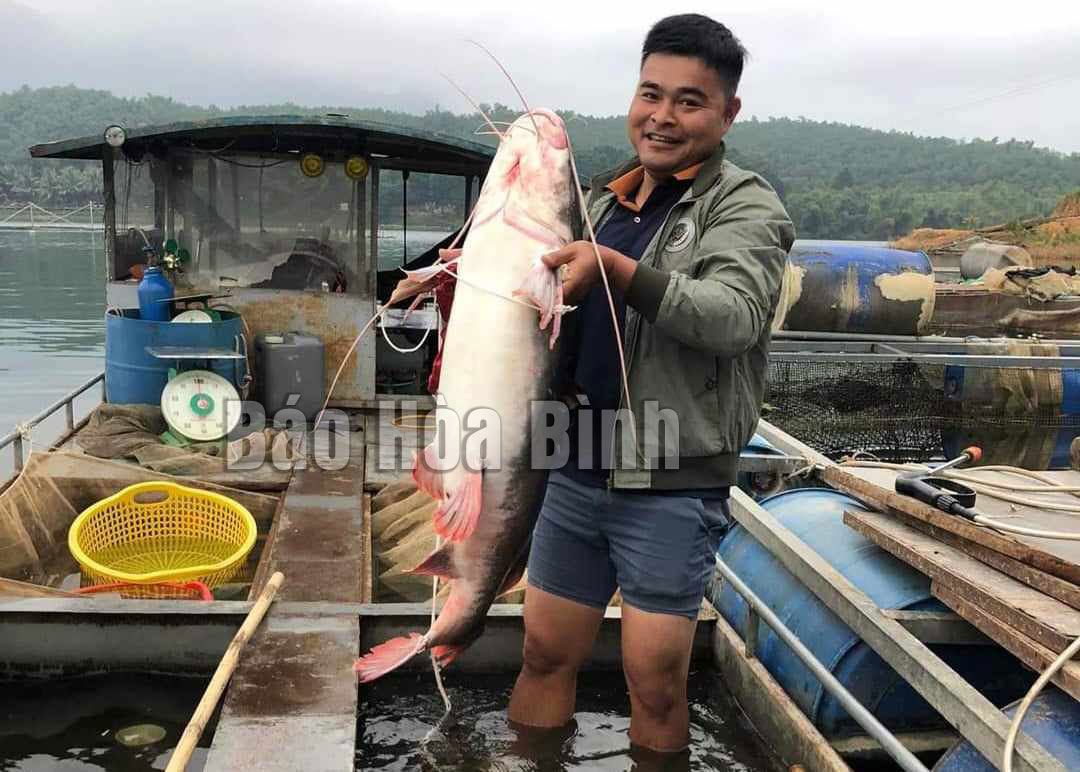
(HBO) - Fish farming has effectively changed the lives of many families in Vay Nua commune of Da Bac district. Taking advantage of the clean water in the lake bed, local residents have switched from fishing to fish farming for a stable source of income.

Cage fish farming
contributes to changing the lives of people in Vay Nua commune, Da Bac
district.
Sang Bo hamlet pioneers in caged fish farming in Vay Nua
commune. As the hamlet is like an oasis in the lake, local people have long
earned their living by planting forests, farming and fishing. When aquatic
resources become scarce, many of them think of cage farming for economic
development.
As one of the first getting involved in pisciculture in the
hamlet, Dinh Cong Son currently has more than 10 fish cages of various types.
His family is also a reliable address for supplying fries and agricultural
services to residents in Vay Nua. He shared: The fish changed the life here.
Raising fish in the lake can both take advantage of agricultural by-products
from vegetables and grass and idle workforce, and produce a steady source of
income.
Ban Van Khanh, Vice Chairman of the Vay Nua commune People's
Committee, said that the commune has more than 700 households, of which 200 are
poor. For many years, local people have lived only on afforestation, rice
farming and fishing. However, afforestation and rice cultivation in mountainous
areas give low and unstable income, and fishing is getting worse due to the
depletion of aquatic resources.
Therefore, caged fish farming is one of local people's "lifebuoy”. From
a few households, to date, five out of eight hamlets have developed fish
farming with more than 500 cages. Local people have bravely borrowed loans to
invest in farming. To date the outstanding debt of the whole commune has
reached 50 billion VND (2.1 million USD), most of which is in fish farming.
Those households are doing business effectively. As a result, the number of
poor households in the commune decreases gradually, added Khanh.
Since the beginning of this year, under the direction of the Department of Agriculture and Environment, the Sub-Department of Agricultural, Forestry, and Fishery Product Quality Management has strengthened the integration of the professional activities to promote and guide the organizations and individuals in the production and trading of agricultural, forestry, and fishery products to comply with the legal regulations regarding the use of chemicals, pesticides and veterinary medicines in crop cultivation, livestock farming and aquaculture. They also provide guidance to processing and manufacturing establishments on keeping the records to trace the product origins and using food additives from the approved list according to the regulations.
Hoa Binh province saw a significant rise in state budget revenue in the first two months of 2025, heard a meeting chaired by Vice Chairman of the provincial People’s Committee Quach Tat Liem.
Ha Thi Ha Chi, a 26-year-old graduate in law, has taken an unconventional path by returning to her hometown in Mai Chau district to establish the Tong Dau Cooperative, creating stable jobs for local women and bringing Thai ethnic brocade weaving to the global market.
As the Lunar New Year 2025 approached, pork prices surged, creating a profitable season for farmers in Tan Vinh commune, Luong Son district. Taking advantage of the rising demand, Can Minh Son, a farmer from Coi hamlet, sold over 30 pigs at 69,000 VND/kg, each weighing more than 100 kg. After deducting expenses, his family earned a profit of over 50 million VND.
alternate member of the Central Party Committee, Secretary of the Hoa Binh provincial Party Committee Nguyen Phi Long on March 5 had a working session with Yan Jiehe, Founder and Chairman of the China Pacific Construction Group, one of China's largest private corporations in the field of transport infrastructure. Deputy Secretary of the provincial Party Committee, Chairman of the provincial People's Committee Bui Duc Hinh and leaders of provincial departments and sectors also attended the working session.
The electronic printed circuit board (PCB) manufacturing and processing plant of Japan’s Meiko Group, located at Da River Left Bank Industrial Park in Hoa Binh city with a total investment of over 200 million USD, is expected to create thousands of jobs and make a significant contribution to the local budget.



